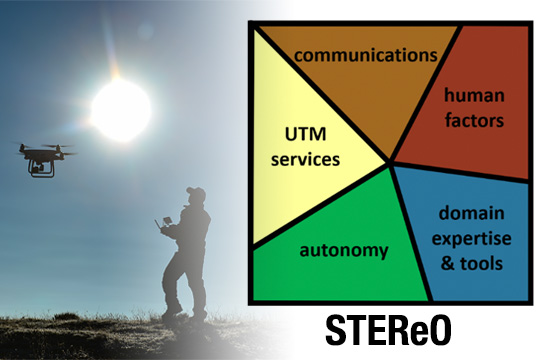|
|
 |

|
 |
 |

Scalable Traffic Management for Emergency Response Operations
Combining NASA technologies and partnerships to transform current-day emergency response operations.
A Convergent Aeronautics Solutions (CAS) execution activity under the Transformative Aeronautics Concepts Program (TACP).
Why STEReO?
Natural Disasters are costing the US billions annually and have resulted in substantial loss of life. Existing disaster response requires extensive manual collaboration and cooperation from a wide coalition of agencies and companies, which is more challenging in a limited communication infrastructure. As emergency responders adopt beneficial technology, they are faced with new challenges on top of existing ones. Ultimately, the timely relay of data into the hands of decision makers enables an efficient and effective response, scaled to the size and nature of the situation. By leveraging and building on existing NASA technologies alongside government, industry, and academic partners, STEReO will improve efficiency and timeliness of the response, mitigation, and recovery phases of a disaster, ultimately saving lives and minimizing the cost to taxpayers.
What is STEReO?
STEReO brings together several technologies in Unmanned Aircraft Systems (UAS) Traffic Management (UTM), Autonomy, Communications, Human Factors, and Domain Expertise & Tools, aimed at providing scalability and flexibility, as well as operational resiliency to dynamic changes during a disaster event. Some of the concepts STEReO explores are:
- Collaborative tools to ingest remote sensing information and distribute a common mission operating picture
- Apply ad-hoc communication networks to facilitate timely information sharing and communication of changes
- Vehicle-to-vehicle and onboard autonomy technologies ensure the safety and resiliency of operations
- Apply NASA's UAS traffic management system (UTM) as a public safety UAS Service Supplier (USS) to access and coordinate use of the airspace by both manned and unmanned operations
Benefits of STEReO
- Standardized, cross-platform communication means increased interoperability and ease of cooperation/collaboration
- Increased situation awareness and common operating picture allow for earlier detection and decision making
- Scalable to size and complexity of environment, operations, and mission objective
STEReO Resources/Presentations/News
- STEReO Overview (PDF, 1.8MB)
-
NASA Ames Research Center features STEReO in an article titled "What is Scalable Traffic Management for Emergency Response Operations?"
- STEReO Overview Video
From Phil So on Vimeo. |
STEReO Workshop
NASA’s Scalable Traffic Management for Emergency Response Operations (STEReO) partner workshop was held on February 11 -13, 2020 at NASA Ames Research Center at Moffett Field, California.
|
Point of Contact: Lauren Claudatos, M.A., Human Systems Integration Division, NASA Ames Research Center |
|
|